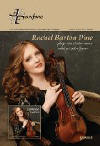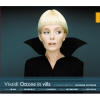|
Excerpts:
Reviewer: Bertil van
Boer
Now,
...,
we have two recordings back to back, one by Il Giardino Armonico using the
same Eric Cross edition of the Chandos, and the second (*)
on budget label Brilliant Classics with L’Arte dell’Arco, using an Italian
edition by Vittorio Bolcato. Both are part (ostensibly) of complete series
of Vivaldi operas, the former as part of the project to record all of
Vivaldi’s immense library (this is Vol. 14 of the theater works), and the
latter because this is something Brilliant Classics does to mass-market
composers. Both claim to have the authoritative autograph behind their
editions, and indeed I could discern very little difference between the two.
Indeed, the only missing number is the final
Allegro
of the Sinfonia in the Brilliant Classics version. Since opera sinfonias
almost always had three movements, and Vivaldi originally included it when
it was published separately as an instrumental work, the Naïve recording is
a bit more “complete.”
"How does one compare the two recordings? Both
ensembles perform the music well with good intonation and tempos. One is a
bit crisper in one aria (for example, the
furore
aria “Par tormento” in the Naïve version features darting string
accompaniment and flexible phrasing, while the Brilliant Classics version is
more restrained), while the other has a cleaner rendition in another (such
as the opening aria of Cleonilla, where there is energy though not always
precision in the Brilliant Classics, but is duller in tone in the Naïve
version). The soloists, too, are variable in their roles; all five in each
recording are fine and perform their often gnarly lines with accuracy and
ease. My preference is for elements of both; I find Sonia Prina’s contralto
more refined and less of a warble than Tuva Semmingsen’s mezzo in the role
of Ottone, but Maria Martorana gives her role as Cleonilla a much brighter
tone than the richer voice of Verónica Cangemi. Both Luca Dordolo and Topi
Lehtipuu are fine in their limited tenor roles, only three brief arias, and
of the Caio Silios, my preference is for Florin Ouatu’s lyrical tone over
the sometimes insecure singing of Julia Lezhneva. All members of the casts
handle the recitatives with swift passion, so they are equal there. In terms
of recording quality, the sound is very much warmer in the Naïve version,
but there are moments, such as Ottone’s second-act aria “Come l’onda,” where
a livelier sound is more welcome. Both are, in a word, fine recordings and
it will come down to a matter of personal preference which to choose..."
The opera itself may not be the
most innovative work in the world and certainly does not achieve the same
moments of greatness that Vivaldi later accomplished, but it is certain to
please those who like Baroque
opera seria.
So, pick one or the other; you won’t go wrong.
* Ottone in villa. L'Arte dell'Arco, dir. Frederico Guglielmo,
Brilliant Classics »BRIL 94 105 |




